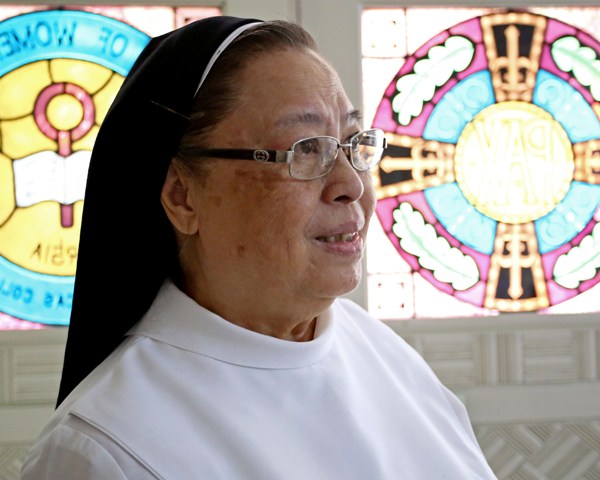Who would have thought Sr. Mary John Mananzan, OSB, that exemplar of the Church Militant, plays Candy Crush?
“And Sudoku, too,” the Benedictine nun says with a grin. “Crossword puzzles. Kina-cut ko pa ’yung sa Inquirer. Dahil may iPad na ako ngayon, computer games naman. Kung nasa traffic ako, at least di ako irritable. A stress-free life—relatively, of course.”
To observers, however, hers has been a long, long life that’s been anything but devoid of stress.
Born on Nov. 6, 1937, in Dagupan, Pangasinan, Mananzan studied at St. Scholastica’s College in Manila from high school through college, graduating with an AB-BSE degree, major in history, magna cum laude.
She took up graduate studies in missiology and systematic theology in Wilhelmsuniversitaet in Munster, Germany. She obtained her doctorate degree, major in linguistic philosophy, summa cum laude, from the Pontifical Gregorian University in Rome.
When did she get the vocation? What made her decide to enter the convent?
“I had the vocation at 19,” she says. She’s now 79. “I had been at St. Scho since I was 11 because of inertia. Ask me instead why I stayed. Nineteen ka, ano’ng alam mo sa buhay? You stayed because you found meaning in it. Napaka-idealistic mo, pero kung di mo naman alam kung ano ang problema…
“So I chose as my cause the preferential option for the poor and vulnerable—the option of Jesus. Of course, there is the Marxist analysis. It’s a blend of Jesus and Marx. But the inspiration is Jesus, not Marx. The Pope has commented that communists are closet Christians.”
Since the ’70s, at the height of Ferdinand Marcos’ martial law regime, she has been at the forefront of political activism, especially concerning gender politics and liberation theology. She is actively involved in developing a distinct Third World theology, specifically for Asia and Africa.
‘Integral evangelization’
She practices what she calls “integral evangelization,” that is, “preaching the Gospel in the context of the total environment—economic, political and social—and all other factors that affect the human destiny.”
She indefatigably works for “integral salvation”—not just the old idea of salvation of the soul from death, sin and hell, but “the liberation of the whole human being from everything that dehumanizes—exploitation, oppression, poverty.”
Mananzan was dean of St. Scholastica’s College for 18 years and its president for six years. She founded the Institute of Women’s Studies and is its executive director.
She co-founded Gabriela, the federation of women’s organizations, and was its national chairperson for 18 years.
On March 8, 2011, at the centennial of International Women’s Day, she was cited as one of the 100 Most Inspiring Persons in the World.
Such are the credentials that have made her reputation as a tough cookie—strict, no-nonsense, formidable, intimidating, even mataray. When you get to know her, though, she’s really fun to talk to.
“Tell them I’m not fearsome,” she says. “I’m not the dictator type. I never make a decision alone. I believe in communal decision-making. Mas maganda ’yung lima kayo mag-iisip kaysa ikaw lang mag-isa na puwede magkamali.”
Being an activist nun, she has no family to be concerned about, and she has institutional support. (A younger sister, CEO of a company selling herbal and health foods, lives in Makati with a family of her own.)
She travels four to five times a year, giving lectures and seminars in over 50 countries on women’s issues, feminist theology, Asian spirituality and other subjects. She just spent 10 days in Australia giving keynote speeches.
In the morning of July 19, she was at Bantayog ng Mga Bayani in Diliman to attend the launch of Duyan Ka ng Magiting, a nationwide protest movement against the burial of Marcos at Libingan ng Mga Bayani.
In the afternoon of the following day, she was taping for a talk show she’s cohosting on cable TV (Destiny Cable and Skycable).
New perspective
Mananzan also writes prolifically, from academic papers on feminism to essays on history and theological matters and even travel articles.
“Nunsense” is her 2012 autobiography. “Nunstop” is the collection of her travel writing published in the Inquirer.
Probably her most famous is “The Woman Question in the Philippines,” slim at 50 pages but heavy with the burden of history.
On July 23, at St. Scholastica’s Archives Museum, she launched her latest, “Shadows of Light: Philippine Church History under Spain—A People’s Perspective.”
Fe Mangahas, a former member of the National Historical Commission of the Philippines, says the subtitle points to the fact that while books on the subject are often from the missionaries’ or institutional point of view—such as Fr. Horacio de la Costa’s history of the Jesuits in the Philippines and Fr. John Schumacher’s account of the encounter between the Spanish religious orders and the Filipino clergy—Mananzan’s focus is on “the receptors, those whose lives were affected” by the Gospel and the teachings of the Church.
Today, she flew to Pambujan, Northern Samar, for the formal turnover of the town’s new 25-bed hospital to St. Scholastica’s Hospital, Inc.
“If you don’t believe in miracles, you can now,” she enthuses on how St. Scholastica’s Mission Hospital came to be in one of the country’s poorest provinces.
When Catarman Bishop Emmanuel Trance wrote to tell how their sick were dying because the nearest hospital was six hours away, and asked if she could help, she was at a loss as she had no idea where to get the funding. Then God extended a hand.
A 3.5-hectare lot was donated by the Salazar family. Building construction was shouldered by Hyundai Asia Resources, Inc., courtesy of CEO Fe Perez-Agudo, a St. Scho alumna and Mananzan’s former scholar whom the nun hadn’t recognized when she offered her company’s commitment.
Five nuns are administering the hospital now. They’re planning to have a mini forest and an herbal garden on the lot.
They have also put up an endowment fund, aiming for P100 million. Mananzan is tasked to do fundraising around the world to keep the hospital operations running and pay the salaries of the staff. Whatever she gets from her books, seminars and lectures goes to the endowment.
Secret of energy
Doesn’t she even slow down or relax at all?
“Relaxed naman ako,” she says. “Nagka-Candy Crush pa nga ako. Many ask me the secret of my energy. I don’t know. Maybe it’s because I meditate.”
A Zen practitioner, she does tai chi for 10 minutes in the garden after the morning Mass, particularly the flowing 18-gesture Shibashi. In the evening, after vespers, she and the other nuns do an hour of meditation in the chapel.
Every Friday she goes to Sunshine Place on Jupiter Street, Makati, and does 40 minutes of meditation with senior citizens.
Does she have a restricted diet? Any food craving?
“I eat anything except sweets, because my doctor says I have diabetes,” she says. “Gusto ko ang santol… Pero walang craving.”
She loves to read detective stories, mysteries and thrillers, Patricia Cornwell crime novels. Her office at the Women’s Studies Center, which is also her residence on Leon Guinto Street, Manila, is cluttered with reading materials, books and journals, souvenirs from her travels.
She also watches movies, inspirational ones, which are screened during the nuns’ recollection once a month.
But in life there is no rest, even for a Zen practitioner. Just when a series of government administrations Mananzan had confronted have gone away, here is another coming her way.
At a multisectoral women’s press conference, during the Q & A, she pointed out that President Rodrigo Duterte had not apologized for his rape joke about that Australian missionary assaulted and killed by prisoners.
“I was bashed by 7,000 of his trolls on Facebook,” says the baffled nun. “Well, did he offer any apology for the joke? You cannot accept what’s not done.”
As for Duterte’s tirades against the Catholic Church, calling it the country’s “most hypocritical institution,” Mananzan says the Church has been here for 2,000 years and its foundation so strong that not even the gates of hell can prevail against it.
The loudness of such people is vexation to the spirit, but she chooses not to be confrontational and add to the noise. She’d rather take the cue from Archbishop Socrates Villegas and keep “the silence of Jesus before the arrogance of Pilate.”
Does she have any plan for retirement?
“Kung pagod ka na, then it’s time to go to the retirement house,” she says. “But if you still have the strength at hindi mo gagamitin, sayang naman. My motto is: Run while you have the light of day. That’s from the Bible.”












































